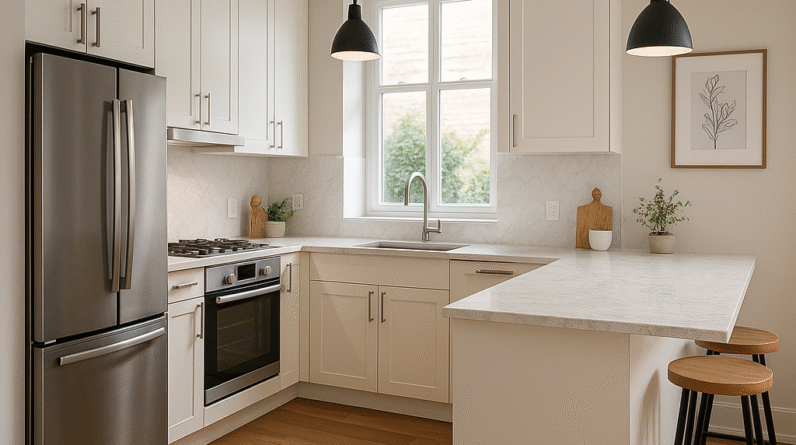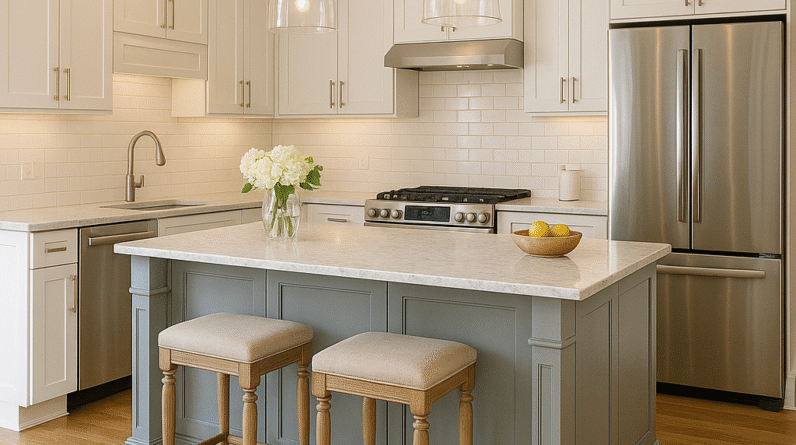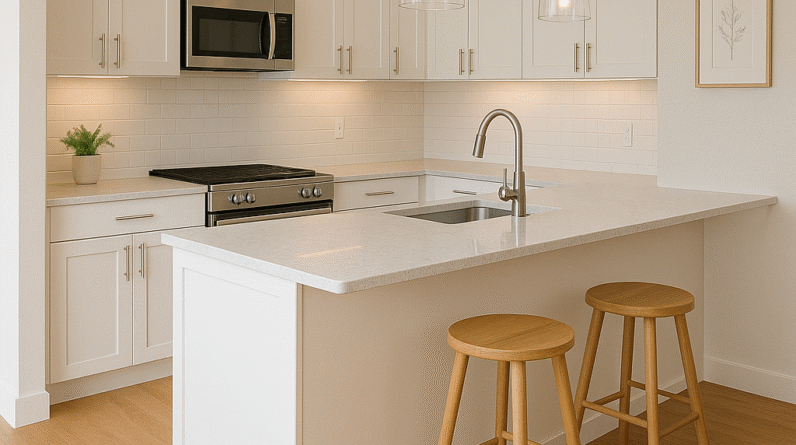
What Is The Most Popular Kitchen Shape?
What Is The Most Popular Kitchen Shape? When it comes to designing your dream kitchen, one of the key decisions to make is choosing the right shape. But with countless options available, it can be overwhelming to determine which shape is the most popular among homeowners. From sleek and modern to traditional and functional, each kitchen shape has its own unique appeal. In this article, we will explore the most popular kitchen shapes that are sure to inspire your next home renovation project. So, get ready to envision the heart of your home in a whole new way!
What Is The Most Popular Kitchen Shape?
When it comes to designing your kitchen, the shape plays a crucial role in the overall functionality and aesthetic appeal of the space. The kitchen shape determines the layout, storage options, and work triangle, making it a vital consideration in any kitchen design project. In this article, we will take a comprehensive look at the different kitchen shapes available, exploring their advantages, disadvantages, and popular trends. By understanding the various kitchen shapes, you can make an informed decision that best suits your needs and preferences.
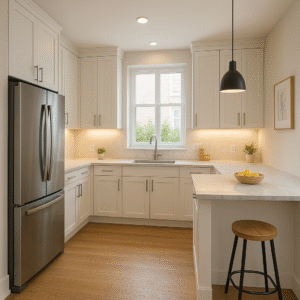
U-shaped kitchens feature cabinets and appliances lining three walls, creating a horseshoe-shaped layout. This design maximizes storage and workspace, making it ideal for larger kitchen areas. The U-shaped kitchen offers plenty of counter space and provides an efficient work triangle, with easy access to all appliances and workstations.
Advantages of U-shaped kitchens include ample storage, as there are cabinets on all three walls, allowing for better organization and functionality. The layout also facilitates efficient workflow, as everything is within reach without the need to move too far. Additionally, the U-shaped kitchen can accommodate multiple users comfortably, making it perfect for families or those who love to entertain.
However, U-shaped kitchens may not be suitable for smaller spaces, as they can make the area feel cramped. The closed-off design may also restrict natural light and airflow, which can be a drawback for some. Nonetheless, with the right design choices and strategic placement of windows, U-shaped kitchens can still be a great option even for smaller kitchens.
L-Shaped Kitchen
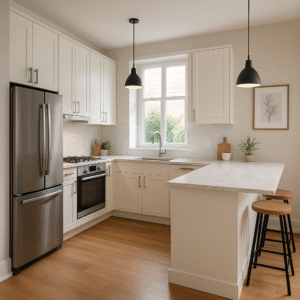
L-shaped kitchens, as the name suggests, form an L shape with cabinets and appliances along two adjacent walls. This design offers flexibility and can work well in both small and large kitchen spaces. L-shaped kitchens provide an open and spacious feel, creating a functional cooking area.
The advantages of L-shaped kitchens include increased countertop space due to the layout’s elongated design. It offers excellent flexibility in terms of traffic flow, allowing for better movement throughout the kitchen. L-shaped kitchens also provide opportunities for additional features such as a kitchen island or dining area, creating a multi-functional space.
However, L-shaped kitchens may have limited storage space compared to other designs. If not properly planned, the corner area may be challenging to utilize efficiently. It is essential to consider employing corner solutions, such as corner cabinets or carousel units, to maximize storage in L-shaped kitchens.
G-shaped kitchens are an extension of the U-shaped layout, with an additional peninsula or partial fourth wall. This design offers even more storage and workspace, making it ideal for larger kitchen areas or those who desire abundant counter space. G-shaped kitchen layouts provide a well-defined work triangle and allow for easy interaction between the kitchen and adjoining areas.
The advantages of G-shaped kitchens lie in their exceptional storage capabilities and abundant countertop space. The additional peninsula or partial fourth wall provides extra room for storage and preparation. G-shaped kitchens also create a separate and defined area for the cook, ensuring privacy and functionality.
However, G-shaped kitchens may not be suitable for smaller spaces, as they can make the area feel cramped and restrict movement. The additional fourth wall can also limit natural light and airflow, requiring strategic lighting and ventilation solutions. Despite these considerations, G-shaped kitchens remain a popular choice for those looking for ample storage and workspace.
Galley Kitchen
Galley kitchens, also known as corridor kitchens, feature two parallel lines of cabinets and appliances, resembling a galley or ship’s kitchen. This design is ideal for smaller spaces or when efficiency and functionality are of utmost importance. Galley kitchens maximize every inch of space and create a streamlined and efficient workflow.
The advantages of galley kitchens include efficient use of space, as everything is within easy reach. They provide excellent workflow, with the sink, cooktop, and refrigerator in close proximity to each other. Galley kitchens also allow for efficient cooking, as there is minimal movement required between workstations.
However, galley kitchens can feel narrow and confined, especially if there is insufficient space for a dining area or kitchen island. The limited countertop space may also pose a challenge for those who require ample room for food preparation. Nonetheless, galley kitchens can be visually stunning and highly functional with proper planning and design.
Single-wall kitchens, as the name suggests, consist of all cabinets, appliances, and workstations along a single wall. This design is commonly found in smaller studio apartments or open-concept living spaces. Single-wall kitchens offer a minimalist and sleek look, maximizing space while providing the essentials for cooking and storage.
The advantages of single-wall kitchens lie in their space-saving capabilities. They are perfect for compact areas where efficiency and simplicity are valued. Single-wall kitchens also create an open and airy feel, allowing for an uninterrupted flow in open-concept spaces.
However, single-wall kitchens have limited storage and countertop space compared to other layouts. It may be necessary to utilize alternative storage solutions, such as wall-mounted shelves or overhead cabinets, to maximize space. Efficient organization and careful planning are essential to make the most of a single-wall kitchen.
Island Kitchen
Island kitchens feature a freestanding workspace or countertop, often with cabinets and appliances integrated into it. This design creates a central focal point in the kitchen and is ideal for larger spaces or those who desire additional seating or entertaining areas. Island kitchens offer versatility and can function as an additional work area, dining table, or even a breakfast bar.
The advantages of island kitchens include increased storage, as the island provides extra cabinet space. It offers additional countertop space, allowing for more people to work simultaneously. Island kitchens also create a focal point in the room, adding visual interest and functionality.
However, island kitchens require ample space, as there should be enough room for traffic flow around the island. It is essential to consider the appropriate dimensions and placement of the island to avoid overcrowding or obstructing the work triangle. Additionally, the integration of plumbing or electrical components may add to the overall cost and complexity of the design.
Peninsula Kitchen

Peninsula kitchens are similar to island kitchens but are connected to one of the existing walls, forming a partial room divider. This design combines the advantages of an island kitchen with the practicality of utilizing existing walls and creating defined zones. Peninsula kitchens offer additional storage and workspace while serving as a transitional element between the kitchen and adjacent areas.
The advantages of peninsula kitchens lie in their ability to provide additional storage and countertop space. They can also serve as a casual dining area or a bar top for entertaining guests. Peninsula kitchens create a sense of separation while maintaining an open and connected layout.
However, peninsula kitchens require careful planning to ensure the seamless integration of the peninsula with the existing layout. It is crucial to consider traffic flow and accessibility when determining the shape and placement of the peninsula. Like island kitchens, additional plumbing or electrical requirements may impact the overall design and cost.
Open kitchens are not limited to a specific shape but rather refer to a layout that seamlessly integrates the kitchen with adjoining living or dining areas. This design promotes a sense of togetherness and allows for easy interaction between the cook and guests or family members. Open kitchens offer a spacious and welcoming environment, ideal for those who love to entertain or have a modern and contemporary aesthetic.
The advantages of open kitchens include enhanced socialization, as the cook can interact with guests or family members while preparing meals. They provide ample space and allow for easy movement between the kitchen and adjoining areas. Open kitchens also provide an abundance of natural light and airflow, creating a bright and refreshing atmosphere.
However, open kitchens may require additional planning for storage and organization, as there are no defined boundaries between the kitchen and adjacent areas. Careful consideration of cabinetry, shelving, and other storage solutions is necessary to maintain a clutter-free and functional space. Despite these considerations, open kitchens remain a popular choice for those seeking a modern and inviting layout.
Conclusion
In conclusion, the shape of your kitchen has a significant impact on its design, functionality, and overall appeal. From the versatile U-shaped and L-shaped kitchens to the efficient galley and single-wall kitchens, each layout has its advantages and disadvantages. The island kitchen and peninsula kitchen offer additional features and transitional spaces, while open kitchens promote a sense of togetherness and modernity.
When choosing a kitchen shape, it is essential to consider factors such as available space, workflow, storage requirements, and aesthetic preferences. What works for one person may not work for another, so it is crucial to evaluate your needs and prioritize them accordingly. By taking the time to understand the various kitchen shapes and their pros and cons, you can make an informed decision that ensures a space that is both functional and visually appealing. Happy kitchen designing!


